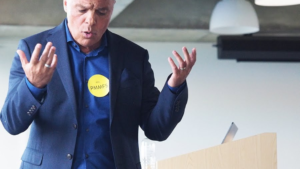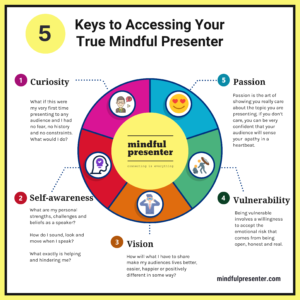
If you find yourself continuing to present your ideas at work in way that doesn’t serve you or your audience as well as you’d both like, it’s likely that you just haven’t accessed your true mindful presenter yet.
We all have one
Do you know what it looks and sounds like?
The true mindful presenter:
– Stands tall, grounded and proud
– Smiles
– Speaks with open gestures
– Is vocally expressive
– Makes good eye contact
– Speaks slowly and clearly
– Pauses and breathes
– Tells stories
– Paints pictures
– Owns the space
– Is open, honest and real
– Leads each time they speak
– Makes people feel something
– Connects emotionally as well as intellectually
– Stands out from the crowd and is remembered
I could go on…
I have stopped here, mindful of the fact that it’s quite a daunting list of attributes.
Please don’t let this list disturb or deter you. We all have a true mindful presenter and with focus and practice have the ability to access it.
Where do I start?
-
Curiosity
One of the greatest intellectual faculties we each have is the gift of curiosity. Developing a mindset of curiosity can stimulate creative thinking, help us to innovate, grow, lead change and communicate more effectively.
Without curiosity, you’ll find people presenting in organisations all over the world doing the same things the same way because, “that’s how everyone does it here.”
What if there were another way?
The best way to access your true mindful presenter is to tune in to your childlike sense of wonder and develop an intense curiosity.
That means creating an insatiable inquisitiveness for what it takes to share your ideas and insights with presence, authority and impact.
In childhood we all had an unquenchable thirst for knowledge and understanding. The journey to accessing your true mindful presenter is to rekindle that natural impulse.
Curiosity starts with asking and answering a number of important questions
– What would it be liking stepping into my audience’s shoes, doing their job, thinking and feeling the way they do?
– If this were my very first time presenting to any audience and I had no fear, no history and no constraints, what would I do?
– What will it take for me to connect with my audience emotionally as well as intellectually.
Like most of our intellectual faculties, curiosity also needs to be engaged in, practiced and strengthened.
Public speaking and presenting aside, the journey begins by:
– Being prepared to be vulnerable
– Asking thought provoking questions
– Challenging the status quo
– Listening very carefully
– Trying new things
– Meeting different kinds of people
– Keeping an open mind
– Scheduling time to be curious
-
Self-awareness
To connect with our audience, it makes sense that we do whatever it takes to connect with ourselves first.
When we become more self-aware, we see ourselves and other people differently. Self-awareness allow us to tune into whether we are thinking, acting or feeling in the mode of ‘auto-pilot’ and we get a sense of whether others are too. In our moments of awareness, we get the choice to continue or to think, feel or act differently
To access our true mindful presenter we need to stay grounded, balanced and authentic. Those qualities are hard to attain and exhibit when we are frantically running around on ‘auto-pilot’. Mindfulness helps us to remember who we really are. That is who your audience came to listen to, not the ‘corporate spokesperson’.
Self-awareness starts with asking and answering a number of important questions
– What are my personal strengths, challenges and beliefs as a speaker?
– What exactly is helping and hindering me?
– How do I sound, look and move when I speak?
– What personal impact do I have on others?
– What are my values?
– How do I see myself and how do I want others to see me?
– What are my limiting beliefs?
Self-awareness is fueled by curiosity and also needs to be engaged in, practiced and strengthened
Public speaking and presenting aside, the journey begins by:
– Finding out exactly how others see you. Ask them.
– Checking in with yourself several times each day. Ask yourself how you are thinking and how you are feeling. Practice mindfulness.
– Being willing to be less defensive and judgmental.
At the end of every day ask yourself:
– What went well and what could have gone better?
– What did I actually think, feel and do today?
– Did I live consistently with my personal values?
– What impact did I have on others today?
– What would I do differently tomorrow?
-
Vision
To access our true mindful presenter we have to help our audience to envision the future. Presenting the facts and sharing information on it’s own is not enough. Our audience need to be able to see exactly what difference our message will make to their lives.
Vision starts with asking and answering a number of important questions.
– How will what I have to share make my audiences lives better, easier, happier or positively different in some way?
– What do I want my audience to think, feel and do after my presentation?
– If my audience were to ‘tweet’ my message to the rest of the world, what would they write?
– What will the future look like for my audience if they act on my message?
The key to mindfulness is being aware of the present; the moment. It’s not about living in the past or the future. That said, the mindful presenter understands that our ability to see the future with a positive level of clarity, reduces fear, doubt and confusion.
Vision comes from curiosity and a higher level of self-awareness
Vision also needs to be engaged in, practiced and strengthened.
Public speaking and presenting aside, the journey begins by:
– Slowing down and calming down. The best way to do this is to develop a mediation practice.
– Practicing visualization.
– Taking a walk and day dreaming.
– Looking at things differently.
– Challenging everything.
-
Vulnerability
In her brilliant TED talk, ‘The power of vulnerability,’ Brené Brown demonstrates the premise that we are all here to ‘connect’ and feel that sense of ‘connection’. It challenges the increasingly popular belief that the route to living our best life is through the principle of ‘control and predict’.
She shares our belief that to access our true mindful presenter another key to connecting is vulnerability.
Being vulnerable involves a willingness to accept the emotional risk that comes from being open, honest and real. Sadly, whilst it’s one of our greatest public speaking assets, it’s the one thing that most presenters are terrified of.
Vulnerability simply means giving your audience a sense of the real you
– They’re not interested in my deep dark secrets; just how they can relate to me on a personal level.
– Do I have a story or experience they can learn from or relate to that tells them more about me?
– Who am I really, beyond my title and expertise?
– Am I prepared to let the audience see the ‘real me’.
-
Passion
Passion is the jewel in the crown of the true mindful presenter. In a previous article, I wrote:
‘It’s hard to connect without passion
Passion isn’t a gimmick, tool or technique; it’s a feeling, an intention and drive.
When you show up with passion for a presentation people pay attention.
They know when you’re passionate because you are animated, engaging, and enthusiastic.
Passion is the art of showing you really care about the topic you are presenting. If you don’t care, you can be very confident that your audience will sense your apathy in a heartbeat.’
Passion is kindled when we ask and answer a number of important questions
– Why is this topic/message so important to me?
– What exactly makes me care so much about it?
– How can I help my audience to feel what I feel?
Some of our clients confide in us that they have no passion for their product, service, company or role. Others ask, how on earth they can be passionate about tax, insurance, algorithms or actuarial science?
Our response is, ‘You have to look for the gold.’
If there really isn’t any ‘gold’ or you don’t have an important message which will make a difference to the lives of your audience, a presentation probably doesn’t need to be made. Consider sending them an email instead.
If you’d like a little help accessing your true mindful presenter:
– Book yourself onto a powerful public speaking course.
– Invest in some really good one to one public speaking coaching.
– Get yourself some excellent presentation training


Leave a comment